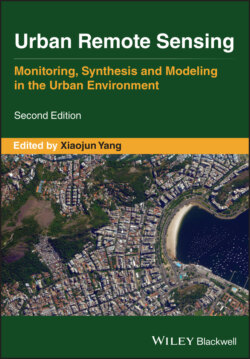Читать книгу Urban Remote Sensing - Группа авторов - Страница 46
3.1 INTRODUCTION
ОглавлениеCities make up 55% of the population in this world, and this number keeps increasing with the continued global trend of urbanization (UN DESA, 2018). Drastic urban growth can be accompanied by various issues such as air pollution, climate change, natural resource depletion, degraded ecosystems, among others. Therefore, effective management of urban areas is critical to human’s collective success. Remote sensing plays an important role in sustainable planning and resource management in urban areas (Seto et al., 2012). Generally, three types of remotely sensed data are commonly used in urban applications and are collected at specific scales to meet different needs: satellite imagery, aerial imagery, and terrestrial data. Among the possible platforms used for aerial imagery, unmanned aircraft systems (UAS) have rapidly become a popular data acquisition technology for a variety of industries and applications over the last decade. While many UAS applications were directed to the fields of forestry and agriculture, there is a lack of comprehensive reviews on the exploration of using UAS in urban areas (Noor et al., 2018). Since UAS is well suited for some urban applications with flexible, low‐cost deployment, high spatial resolutions, and dynamic sensor combinations, this chapter aims to provide an overview of the concept of UAS and to discuss its potentials and limitations in urban applications.
In general, a UAS is a system comprising an unmanned aircraft (UA), a ground control system (GCS), and a communication data link between the UA and the GCS. Another common term unmanned aerial vehicle (UAV) only refers to the UA component of UAS (Colomina et al., 2008). Due to the low‐cost associated with UA compared to manned aircraft, UAS applications have been gradually extending into other fields, such as precision farming (Zhang and Kovacs, 2012; Sonka and Ifamr, 2014; Tsouros et al., 2019), forestry (Howell et al., 2018; Jayathunga et al., 2018), ecology (Anderson and Gaston, 2013; Hodgson and Koh, 2016), and disaster management (Restas, 2015; Bravo et al., 2019). UAS can overcome many challenges faced by traditional land survey methods, including performing under hazardous environments and reaching areas that are impossible for manned aircraft to enter. In circumstances where traditional manned aircraft cannot operate, such as low altitudes, areas with physical obstacles, and poor weather conditions, UA provide a much safer and lower‐cost alternative to collecting remote data. Compared to satellite imagery, images captured with UAS can be generally free of clouds and have a very high spatial resolution due to the closer proximity to the ground surface. Most importantly, UAS platform and sensor combinations allow the generation of coherent spectral information (i.e. ortho‐mosaic imagery) and terrain information (Digital Surface Models, DSMs), which are valuable topographic‐related analyses. Given these appealing characteristics, there is currently a surge in remote sensing research investigating the potential of UAS technology in a myriad of scenarios. In recent years, there has been a notable increase in the number of remote sensing projects conducted in rural environments, but much less in urban areas (Singh and Frazier, 2018). Most of these studies were focused on geographic areas with minimal human activities due to regulatory challenges and operational risks, such as maintaining safe conditions while flying in the vicinity of people. Rural locations for UAS flights tend to have fewer physical obstacles, greater visibility, and less nonparticipating individuals in the vicinity, thus resulting in significantly lower risk. Due to these reasons, there is currently a pressing need to explore the full potential of UAS for remote sensing in urban settings.
Due to the heterogeneity and complexity of urban landscapes, deriving urban settlements and land cover information from remote sensor imagery can be challenging (Jensen and Cowen, 1999; Kit et al., 2012). UAS is a convenient data collection platform for urban applications given its flexible control over scale, camera types, and data outputs. With a UAS, users can have more direct control of the geographic extent of an area of interest (AOI), the spatial resolution of the image data, and the temporal resolution of the datasets by creating predefined flight missions. These variables can be influenced by adjusting the flight height and temporal intervals between multiple flight missions, respectively (Singh and Frazier, 2018). In this way, researchers can collect data only in the AOI with the desired resolution that can capture the variation of a phenomenon without getting needlessly too detailed (or needlessly taking too long). Many efforts have been made to improve urban mapping using active remote sensing through platforms mounted with high accuracy sensors, such as radar or light detection and ranging (LiDAR) sensors (Tison et al., 2004; Gonzalez‐Aguilera et al., 2012; Ban et al., 2015; Wurm et al., 2017). Due to advancements in photogrammetry, both spectral information and elevational information can be derived from UAS images. By mounting different sensors or cameras, UAS can also capture multi‐sourced information including hyperspectral information, thermal information, and laser scanning images in the same flight period, which can greatly very valuable for urban remote sensing. In addition to still imagery, UAS is also capable of recording videos, which can provide important geographic and environmental information of an AOI.
This chapter discusses both the opportunities and challenges of UAS in urban applications. It is organized into five sections covering the advantages of UAS in urban remote sensing, common UAS models and camera types, UAS data collection and data processing, urban applications using UAS, major challenges and possible solutions, and conclusion and prospects.
